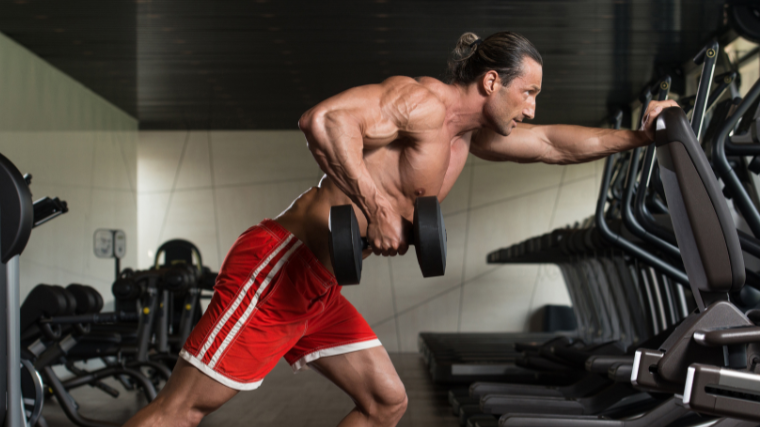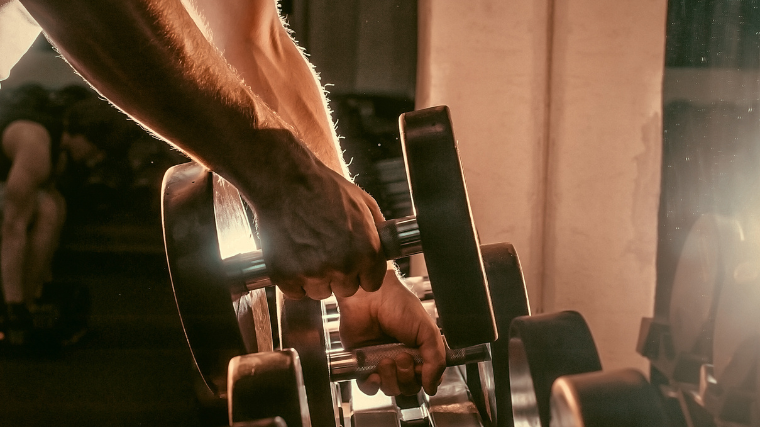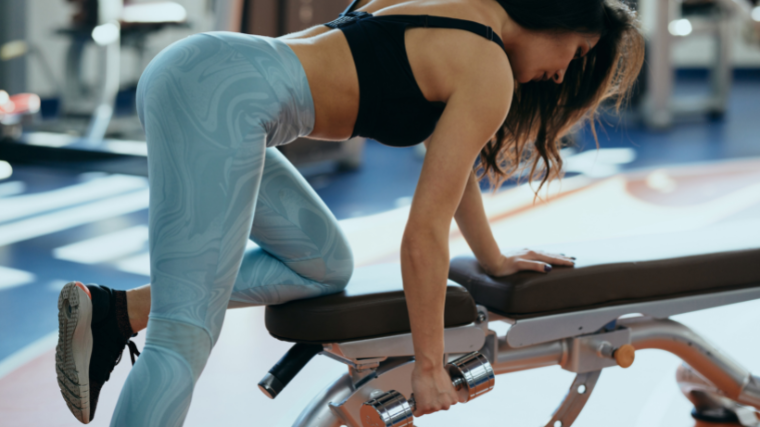Bodybuilders work with whatever equipment they have to in order to build muscle. Some prefer the barbell for its high loading capacity; others rightfully revere the cable tree for its constant tension and versatility.
The humble dumbbell rack is a find-it-everywhere fixture in commercial gyms for good reason. Dumbbells serve as a phenomenal middle ground between the go-hard-and-heavy barbell and the precision offered by cables or machines.

But the question remains; what are the best dumbbell exercises for muscle growth? What can you do with dumbbells that you can’t get done elsewhere — at least, not as well?
Look no further. These are some of the best movements you can do with a dumbbell or two.
Best Dumbbell Exercises for Bodybuilding
- Dumbbell Incline Bench Press
- Dumbbell Flye
- Dumbbell Row
- Dumbbell Pullover
- Dumbbell Lateral Raise
- Dumbbell Rear Delt Flye
- Dumbbell Curl
- Dumbbell Romanian Deadlift
- Dumbbell Lunge
- Dumbbell Russian Twist
Dumbbell Incline Bench Press
Building three-dimensional pecs takes more than your tried-and-true barbell bench press. The incline dumbbell press is probably the second-most recognizable pec builder you’ll see in a chest workout, and for good reason. Few compound lifts hit your upper chest quite as well.
Benefits of the Dumbbell Incline Bench Press
- Allows for more freedom of movement at the shoulder than the barbell can provide.
- You can adjust the bench to find the exact right angle to blast your upper chest with.
- Dumbbells help you identify and attack muscular imbalances.
How to Do the Dumbbell Incline Bench Press
Set an adjustable bench to a low-to-moderate incline. You should prioritize comfort first and foremost, but take note — some scientific research has revealed that a higher incline of around 40 degrees may increase muscle activation at the upper chest. (1)
Then, sit on the seat with a dumbbell resting on each of your knees. In one swift motion, “kick” the dumbbells backward while you lean back onto the bench. Press the weights up to arm’s length, directly over your shoulder. From here, lower the dumbbells down and out slightly, reversing the motion as you press them up and inward toward each other.
Dumbbell Flye
You can’t use a barbell for every anatomical function your body performs. For instance, there’s simply no practical way to perform abduction of the upper arm (that is, letting your arm drift out to the side) with a barbell.
That’s where dumbbells come in clutch. Your pecs help pull your arm into your torso from the side, a motion you’ll want to perform with a pair of dumbbells most of the time when you do the flye exercise for your chest.
Benefits of the Dumbbell Flye
- Allows for a high amount of mechanical tension on the pecs with even light weights.
- Places the most tension and torque on the pecs when they’re fully lengthened, which is great for hypertrophy.
How to Do the Dumbbell Flye
Lie on your back on a flat bench with a light dumbbell in each hand at arm’s length above your head. Slowly open your arms up, letting them fall to the sides under control and with a slight bend in your elbows.
Lower the weights until your arms are parallel to the floor or you experience discomfort, then reverse the motion and sweep them back up to the starting position.
Dumbbell Row
Rowing is an essential motor pattern when it comes to growing your back. You can row just about anything; a barbell, a cable handle, or even your own body weight. However, dumbbells might take the cake here, especially over the barbell.
The dumbbell row lets you load up on heavy weight without placing a lot of torque on your lower back or legs.
Benefits of the Dumbbell Row
- Allows you to work each side of your upper back independently.
- Great for beginners or those who are sensitive to lower back strain.
- You can work with very heavy weights for solid progressive overload.
How to Do the Dumbbell Row
Place the corresponding knee of your non-working arm onto a flat bench. If you’re rowing with your right arm, that’s your left knee. “Spike” your right leg out and back behind you, like a kickstand on a bicycle.
Put your non-working arm on the bench as well, with your elbow locked out to support your torso. Grab the dumbbell from the floor with your working arm. While maintaining a roughly-parallel-to-the-floor torso, row the weight up until your arm aligns with your trunk. Keep your shoulder down and think about pulling with your elbow.
Dumbbell Pullover
Few exercises out there work two opposing muscles at the same time; enter the pullover. When performed with a dumbbell, pullovers allow you to load your lats and pecs at the same time through the pattern of shoulder extension. They’re an incredibly time-efficient muscle-builder.
Benefits of the Dumbbell Pullover
- Lets you work your pecs and lats at the same time.
- Good for developing shoulder mobility and stability.
- Easy to learn, and is effective with even a light weight.
How to Do the Dumbbell Pullover
Lie on your back on a flat bench with a single dumbbell held over your head. Your hands should clasp the cylindrical plates of the dumbbell, not its handle. Put your palms on the undersides of the plates.
Then, slowly lower the dumbbell back behind your head with a mostly-straight arm, kind of like you’re doing a chest flye. Lower the weight as far as you can, until you feel a nice stretch through your lats and upper chest. Reverse the motion by contracting those muscles until the weight once again enters your eye line.
Dumbbell Lateral Raise
There are no “essential” exercises in bodybuilding. Well, almost — the lateral raise is, for the most part, the only way to isolate and grow the medial head of your deltoid. If you want round, capped shoulders, you have to do your laterals. Dumbbells are probably the best place to start.
Benefits of the Dumbbell Lateral Raise
- Allows you to hit a muscle you can’t properly stimulate with other movements.
- Even a light dumbbell will be effective at torching your delts with this exercise.
- You can perform lateral raises from a variety of different angles.
How to Do the Dumbbell Lateral Raise
You can start with the “default” lateral raise technique and customize it from there. Stand upright with a dumbbell in each hand. Take a very slight lean forward so your arm hangs straight down; the dumbbells should gently touch the outsides of your thighs.
From here, sweep the weights up and out, with your arms kept straight. Lift the weights until your arms are almost parallel with the floor, then lower them back down.
Dumbbell Rear Delt Flye
Muscles like your rear deltoid are tiny and can be difficult to properly stimulate for hypertrophy. You need the exact right movement from the correct angle and a solid mind-muscle connection.
The dumbbell rear delt flye accomplishes this in spades, while also being a fantastic general prehab movement for the health of your shoulder.
Benefits of the Dumbbell Rear Delt Flye
- Allows you to isolate the small muscles of the posterior shoulder.
- Great for scapular prehab and control.
How to Do the Dumbbell Rear Delt Flye
Lay on your stomach on a low-incline bench or hinge over at your hips until your torso is roughly parallel to the floor. Let your arms hang down loosely with a light dumbbell in each hand.
Some studies showcase that a neutral grip, in which your palms face each other, is better for activating the rear deltoid, (2) but your mileage may vary.
Raise your arms out to your sides, while keeping your shoulders down away from your ears. Think about sweeping your hands out wide, instead of raising them up high. Lift your arms until they’re slightly higher than your torso, then lower the dumbbells slowly back down.
Dumbbell Curl
There are a wide variety of curls you can use to grow your guns, but the standard dumbbell curl stands second to none. Sometimes, simple is better; the dumbbell curl allows you to work your biceps separately for proportional development, and is as easy to perform as grabbing them off the rack and getting to work.
Benefits of the Dumbbell Curl
- Allows you to work each of your biceps individually for balanced muscle growth.
- Easy to perform and has a relatively straightforward technique.
- Good for beginner and advanced bodybuilders alike.
How to Do the Dumbbell Curl
You can perform the dumbbell curl standing or seated. Hold a pair of dumbbells in each hand at your sides with your shoulder externally rotated — make your palms point forward.
Then, bend your elbow to curl the weight upward with your biceps as high as you can. Curl until your elbow is fully compressed, but don’t let your upper arm drift forward. Keep it tucked tightly to your sides.
Hold the weights in the flexed position at the top for a beat before lowering them slowly back down, maintaining that externally-rotated shoulder the whole way.
Dumbbell Romanian Deadlift
You can get one heck of a leg workout in with just a barbell, but that doesn’t mean you should shy away from the dumbbell rack if you’re looking to build your legs.
The dumbbell Romanian deadlift is a phenomenal movement for loading up your backside, without placing quite as much strain across your lumbar spine if you find that to be the limiting factor in your performance.
Benefits of the Dumbbell Romanian Deadlift
- Allows you to train your lower back, glutes, and hamstrings all at once.
- Dumbbells let you adjust your setup and execution to make the movement a bit friendlier on the lumbar spine.
How to Do the Dumbbell Romanian Deadlift
Stand upright with a heavy dumbbell in each hand — you might want to consider performing this one with the assistance of lifting straps. Hold the dumbbells in front of your legs. If you find your lower back is irritated by hinge exercises, try moving the dumbbells closer to the sides of your legs instead.
Initiate the exercise by unlocking your hips and pushing your butt backward. Your knees should be unlocked, but not noticeably bent. Think about moving into a low, respectful bow, while the weights slide down your legs. Keep the dumbbells close to your body and bend over until you feel a pronounced stretch in your hamstrings.
Reverse the motion with your glutes and shoot your hips forward, locking them back out explosively at the top.
Dumbbell Lunge
Dynamic leg exercises like the lunge are perfectly suited for dumbbells; they also happen to be great for growing your quads and glutes, while adding some welcome balance-oriented training into the mix.
If you have the floor space and two dumbbells, you can walk your way to top-tier leg development.
Benefits of the Dumbbell Lunge
- Dumbbells are easy to utilize in the lunge exercise without requiring a complex setup routine.
- Dumbbell lunges are great for beginners who only need a little bit of weight.
- Lunges allow you to work each of your legs independently over the course of one large set.
How to Do the Dumbbell Lunge
Hold a pair of medium-weight dumbbells at your sides in a clear, unobstructed area. You’ll need a good 30 feet of walking space in most cases. Begin the lunge by moving one leg outward and planting it roughly two feet in front of you, and then sinking into it until your knee is bent at a 90-degree angle.
Push off with that leading leg to move yourself forward. Lift your back leg off the ground and drive it in front of you. Repeat with that leg, using your non-working leg for balance. Lunge for a specific number of repetitions or steps.
Dumbbell Russian Twist
Admittedly, dumbbells aren’t necessarily the best tool for training your core. You might have more success with a cable tree or, commonly, your own body weight. That said, there are a few movements for ab growth that are well-suited for dumbbells such as the Russian twist.
Benefits of the Dumbbell Russian Twist
- Trains your core to both perform and resist thoracic rotation.
- You don’t need very much equipment to perform this exercise.
- Great for beginners before moving onto harder forms of ab training.
How to Do the Dumbbell Russian Twist
Sit on the floor with your legs bent. You should clasp a single dumbbell in your palms and hold it aloft in front of your chest. From here, with your torso at a roughly 45-degree angle relative to the floor, twist your upper body from side to side as if you were trying to place the dumbbell down beside you.
Rotate back and forth slowly by contracting your abs and obliques, ensuring that the dumbbell remains in one place and moves in sync with your torso.
Benefits of Dumbbells for Bodybuilding
Dumbbells aren’t the endgame of resistance training, but they’ve been a weight room mainstay for decades for good reason. When it comes to muscle growth specifically, you really can’t go wrong with a pair of dumbbells in-hand. Here’s why.
More Freedom of Movement
Your muscles pull and rotate around specific paths and axes. The way your arm moves in space during the bench press (an action performed by the pectoralis muscle) will never be quite the same as your gym partner’s.
As such, the equipment you work with to train your body should enable as much free and uninhibited movement as possible, while still being loadable and sustainable.
Dumbbells are key here. Where a barbell fixes both of your limbs to the same object, dumbbells allow your arms or legs to move independently as needed.

Freedom of movement isn’t directly relevant to hypertrophy, but it sure helps. Research indicates that certain planes of motion are uniquely suited to dumbbell work; think of the long, sweeping motion of a chest flye. (3)
Other literature indicates that the uninhibited motion of dumbbell training may lead to higher muscle activation overall than what you can get from a barbell or machine station. (4) No matter how you slice it, dumbbells are a first-rate piece of lifting equipment for packing on mass — especially when you perform the correct movements with them.
Convenient Progressive Overload
Mechanical tension and regular progressive overload — that is, incrementally increasing the challenge of the exercise through added weight, sets, reps, or another metric — are integral to muscle growth.
Barbells tend to reign supreme here due to their loading potential. You can bump a barbell movement by a meager five pounds and hardly notice, depending on the lift you’re doing. Dumbbells offer this as well, but not to the same degree. However, it’s much easier to ratchet up your dumbbell work since they’re all clumped together on a rack.
You may even be able to find dumbbell sets at your gym that increase by 2.5-pound increments. Still, for most exercises, the ability to pick up a slightly heavier pair quickly and conveniently is an undeniable perk of working with dumbbells to drive progress long-term.
Helps Reveal and Address Muscular Imbalances
Working one leg (or arm) at a time is good for more than developing robust joint stability and postural control. When it comes to bodybuilding, a pristine physique is also proportional; something you may not be able to achieve if you only work bilaterally.
A barbell bench press, for instance, might mask the fact that one side of your body is performing more work than the other. Over time, this could create lopsided gains in size or strength.

Making dumbbell work a regular part of your routine can help you identify and tackle these issues before they develop. You’ll notice very clearly if one pec, or biceps, or quad, isn’t keeping pace with the other.
Level Up With Dumbbells
The versatility and utility of dumbbells are unparalleled. You could build an entire workout around them if you wanted to and make some mighty impressive gains along the way.
At minimum, you should consider including these 10 movements into your bodybuilding routine. Finding the right tool for the job is half the battle in bodybuilding — head for the dumbbell rack if you want to win the war.
References
1. Trebs, A. A., Brandenburg, J. P., & Pitney, W. A. (2010). An electromyography analysis of 3 muscles surrounding the shoulder joint during the performance of a chest press exercise at several angles. Journal of strength and conditioning research, 24(7), 1925–1930.
2. Schoenfeld, B., Sonmez, R. G., Kolber, M. J., Contreras, B., Harris, R., & Ozen, S. (2013). Effect of hand position on EMG activity of the posterior shoulder musculature during a horizontal abduction exercise. Journal of strength and conditioning research, 27(10), 2644–2649.
3. Solstad, T. E., Andersen, V., Shaw, M., Hoel, E. M., Vonheim, A., & Saeterbakken, A. H. (2020). A Comparison of Muscle Activation between Barbell Bench Press and Dumbbell Flyes in Resistance-Trained Males. Journal of sports science & medicine, 19(4), 645–651.
4. Farias, Déborah & Willardson, Jeffrey & Paz, Gabriel & Bezerra, Ewertton & Miranda, Humberto. (2016). Maximal Strength Performance and Muscle Activation for the Bench Press and Triceps Extension Exercises Adopting Dumbbell, Barbell, and Machine Modalities Over Multiple Sets. The Journal of Strength and Conditioning Research. 31. 10.1519/JSC.0000000000001651.
Featured Image: Jasminko Ibrakovic / Shutterstock